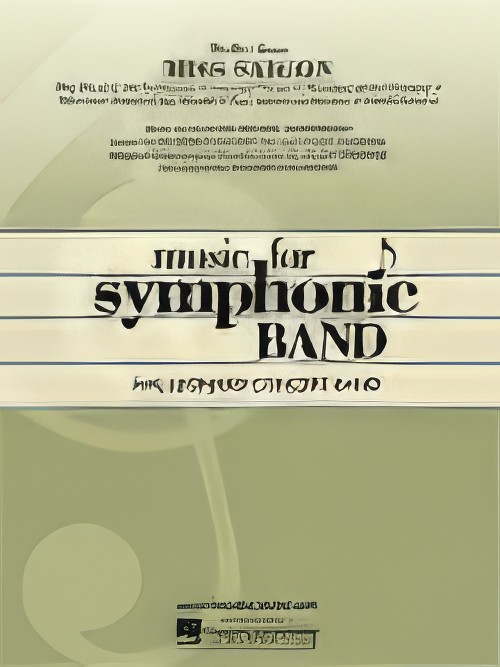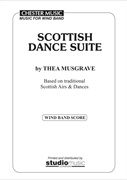Results
-
 £144.99
£144.99Jungle (Concert Band - Score and Parts)
In this fascinating piece we experience an exciting adventure in the jungle. The entrance into the "green hell" turns out to be very dangerous with wild monkeys and the roaring of elephants accompanying our way through the dark forest. There seems to be something lurking behind every tree and all of a sudden, a horde of savage cannibals appears. A wild hunt sets off and we escape at the last second by jumping from a cliff into the savage water below. Exotic birds welcome us in a new landscape and from somewhere in the distance we can hear a bamboo flute playing. This is a journey of no return.... The effects (elephants, wild monkeys, exotic birds and rain) should be produced with much creativity - individual ideas are always desirable and welcome. 08:00
Estimated dispatch 7-14 working days
-
 £144.99
£144.99Like a Child Wind Band Set (Score & Parts)
The young have the future. This is the statement made at the beginning of 'Like a Child' by Andreas Ludwig Schulte. The opening radiates strength and ambition, but one is also made to wonder which direction will be chosen, which choices will have to be made.After the introduction the first steps on the path of life are taken, still somewhat unsteadily (the 3/4th time used illustrates this uncertainty). However, the child has now set off and will meet the future with an open mind, unafraid, even though experience will teach it how easily it can be hurt.Fortunately, it is sometimes allowed to be vulnerable and it discovers there will always be someone to offer shelter, support and love. (Adagio) The last part breathes a far greater independence. Youth is able to face the future, it can even take on the whole world! 07:45
Estimated dispatch 7-14 working days
-
 £76.99
£76.99MISS SAIGON (Concert Band) - Barker, Warren
(Sun and Moon; The Heat Is on in Saigon; The American Dream; I Still Believe; The Last Night of the World)
Estimated dispatch 7-14 working days
-
 £76.99
£76.99Neckarmarsch (Concert Band - Score and Parts)
The town of Schwenningen at the source of the Neckar inspired Wolfgang W?ssner to compose this march song. In the trio he employed Friedrich Silcher's well-known folk song Am Neckar. The march is composed in 6/8 time throughout, with the folk song theme likewise arranged in this meter. An optional performance with male choir is possible, with the first two verses, together with the last verse, sung. 02:40
Estimated dispatch 7-14 working days
-
 £84.99
£84.99Paso Bella Wind Band Set (Score & Parts)
Paso Bella is full of the typical fiery and melodic characteristics of the paso doble. The hot Spanish temperament can be heard from the opening themes in the minor key, as is usual in a paso doble, to the last bars of the trio. The trio is followed by an exuberant closing which will reverberate in the ears of both musicians and audience for a long time. 0:04:30
Estimated dispatch 7-14 working days
-
 £89.99
£89.99Prima la Musica (Concert Band - Score and Parts)
This work describes the development of a local village band as it grows in both size and ability to become a symphonic wind band. It is dedicated to all orchestras that follow the same, sometimes hard, road. No matter what, the focus should always be the music, providing us with the energy and motivation we need along the way! With this in mind the march Prima la Musica reflects a spirit of change and optimism from the first to the last note. 04:30
Estimated dispatch 7-14 working days
-
 £84.99
£84.99Scherzpolka (Concert Band - Score and Parts)
In the somewhat sarcastic Scherzpolka (Joke Polka), the composer does not intend to make fun of Alpine traditions and music but rather of the typical social attitude that does not always do justice to the valuable folk music and culture. Imagine a band that has to play in a beer tent for hours. During the performance the guests treat the musicians to one beer after another. Gradually, the players and the conductor lose control over their instruments and their interpretation of the music. Finally, the performance comes to an end: the Scherzpolka is actually the last piece. There are no limits to the creativity in both the visual and musical aspects during a performance of the Scherzpolka! 02:30
Estimated dispatch 7-14 working days
-
 £164.95
£164.95SCOTTISH DANCE SUITE (Chester Wind Band) - Musgrave, Thea
Score & Parts. The Scottish Dance Suite is based on traditional Scottish folk songs and dances, though several less well-known tunes are used. For instance in the second of the four movements, one can hear the older tune of The bonnie Earl of Moray, and in the first movement, the tune is the one to which Burns wrote his famous poem Robin shure in hairst. In the last movement, two well-known tunes alternate, but at the end several of the tunes used in the work all combine together to make an exciting climax. Duration: 8mins.
Estimated dispatch 7-14 working days
-
 £32.95
£32.95SCOTTISH DANCE SUITE (Chester Wind Band) Extra Score - Musgrave, Thea
Extra score only. The Scottish Dance Suite is based on traditional Scottish folk songs and dances, though several less well-known tunes are used. For instance in the second of the four movements, one can hear the older tune of The bonnie Earl of Moray, and in the first movement, the tune is the one to which Burns wrote his famous poem Robin shure in hairst. In the last movement, two well-known tunes alternate, but at the end several of the tunes used in the work all combine together to make an exciting climax. Duration: 8mins.
Estimated dispatch 7-14 working days
-
 £159.99
£159.99Solemnitas (Concert Band - Score and Parts) - Cesarini, Franco
Each year on the last Monday in June, the German city of Burgdorf celebrates the holiday of youth, the so called 'Solennitat'. It is the most important event occurring in the city and consists of three processions walking through the centre of town to celebrate, at the city's expense, the good results achieved in school. This new work by Franco Cesarini takes it's inspiration from this event and leads us through contrasting variations of a Swiss folk tune.Duration: 12:15
Estimated dispatch 7-14 working days
